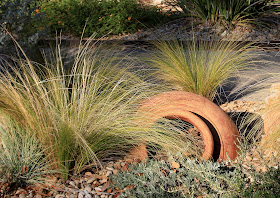It's tough to beat Nasella tenuissima for native grasses in the xeric landscape. When looking for ideas for my own yard, I was quickly drawn to the large swaths of softly waving grasses in commercial landscaping around town. Commonly known as Mexican Feather Grass or needle grass its showy tresses swish in even the gentlest of breezes and add beautiful texture to local gardens in every season. Native to west Texas, eastern New Mexico, and south across the border into Mexico it is at home planted here in central Texas just outside its native habitat.
The graceful grasses really shine in the front yard where I have used them to soften the edges of the driveway. Heat and sun are not a problem for this tough plant. These were planted by dividing several pots into tiny plugs last spring so you can see how quickly they've grown with only occasional supplemental watering. They are beginning to take on the blonder colors of fall now. If I find the plants are getting brown, I just reach in and remove the spent stems to refresh them.
They reseed prolifically and several have planted themselves in gravel across the drive near the street. Starting from a tiny seed last spring this one has grown impressively fast so be prepared to pull them out if you want to keep them in place. Mexican feather grass is considered invasive in some areas so check before you plant if you live in an environmentally sensitive area.
Nasella Tenussima is an easy care, easy grow plant and an asset for the xeric garden.
The ABCs of Plants in my Garden series highlights individual plants in my garden and my experience with them. I have created a reference page under the tab at the top.





I suppose you could go backwards in time and use it for the letter S also. As in Stipa. he he. Yes I use this plant a lot in my own garden. The movement of the plant is phenomenal.
ReplyDeleteAs a matter of fact while researching this post I read that it might go back to Stipa. S is reserved for Sophora Secundiflora of course.
DeleteJusticia/Dicliptera is another one that moves around so I put the shrimp plants in Justicia and the Wooly Justicia will be under Diclptera.
For the longest time I just didn't see the beauty of this plant. Finally a little over a year ago it clicked, and I love it. Now I am starting to fear it's seeding itself around in my gravel. I have a feeling I am going to have about a half million more plants than I want!
ReplyDeleteIt is prolific and it does look great with spiky plants. Ah, the choices we have to make.
DeleteThat grass looks perfect in your landscape.
ReplyDeleteThank you Mary, I know you appreciate native plants used in the best context.
DeleteI use this one a lot. It's great in these droughts we keep having. And, it softens all those prickly other drought resistant things.
ReplyDeleteI have quite a few 'babies' to move to other places, too.
Isn't it amazing, you only need a few to start with. Just right with all our prickly plants tood.
DeleteThis looks fabulous in your garden. I use Carex buchanii in much the same way.
ReplyDeleteThank you ricki, Carex needs lots of shade here. I have a few in the shade. Our sun and heat calls for plants that can take it.
DeleteGreat look you've created with the massings of TX Sage plants and the Feathergrass. Movement - both in the wind, and extreme volunteering. I still pull out a few every week or so, after removing the 20+ I planted back in '98, and hundreds of volunteers. I especially like it under oaks, or like you show with the buried pots.
ReplyDeleteThe desert is not the place for this grass so it's good you pulled this out. It's fine here, doesn't escape into the wild.
DeleteThanks for the idea, I might try grasses or something similar under the oaks where I need to hide the oak sprouts.
I love the look of this grass in a garden, especially how you used it in the landscape.
ReplyDeleteThank you Donna, it workes best the way we use it here in San Antonio.
DeleteTough grass that works well in our areas. I like the accent use you have here. Here, we get lots of volunteers so we have to be careful where we place them:)
ReplyDeleteCertainly the desert is not the best place for these. I have read some information about these escaping into the wrong part of the desert so be careful.
DeleteIt does look fabulous.
ReplyDeleteThank you Bernie. I know Nasella is escaping cultivation in Australia which is a serious problem where it is thousands of miles outside its native range. It's important for everyone to ensure they plant what's best for their locale.
DeleteNassellas are lovely grasses. We have a couple of Nassella species that are native to this area, including our official state grass, Nassella pulchra. I'm trying to gradually incorporate more grasses into the gardens. I love the delicate look of this species, and of course, grasses always add so much movement to the garden with even the lightest of breezes. I'm sure your photos will inspire a few more not to overlook the effect of grasses in the landscape.
ReplyDeleteThat's great information to know that different Nasella species work in California because I have heard that N. Tenuissima is a problem there. These grasses are a great way to cover much ground in the landscape.
DeleteLooks great Shirley - you must love your drive into your yard so much.
ReplyDeleteThank you Heather, we do enjoy driving up to the house so much more than before. Even better is when the neighbors make positive comments.
DeleteI love the feel of this grass and the way it caresses your legs from the edges of a path as you pass by.
ReplyDelete